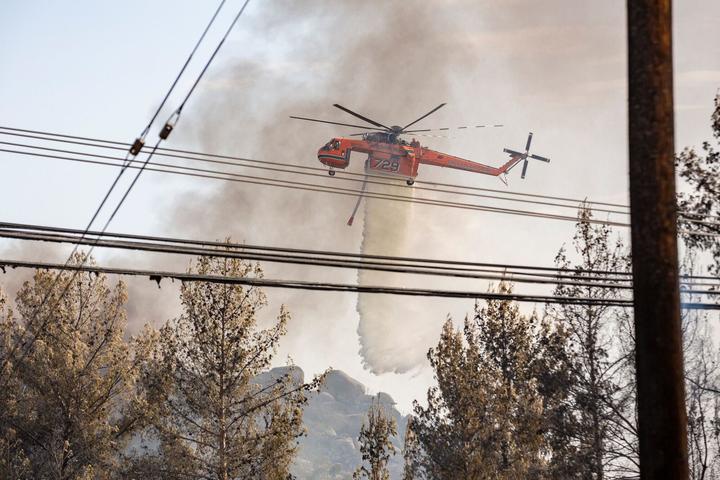In our region, rising temperatures, prolonged drought conditions, and severe weather patterns present us with an ongoing challenge — devastating wildfires. And they can happen any time, for many reasons and become uncontrollable very quickly, as the recent West Fire in Alpine proved. To combat this threat and uphold our No. 1 priority of public safety, we’ve established a new Fire Science & Climate Adaptation Department. The newest addition to this team is meteorologist Carrie Bowers whose specialty is fire science.
Carrie has extensive experience as a wildland firefighter and served for nine years with the U.S. Forest Service. She transitioned from a firefighter to meteorologist because she was fascinated by the weather classes she took as a firefighter. Her experience with firefighting, coupled with her knowledge of meteorology/fire weather, will help us navigate the risk associated with dangerous conditions.
Team members in our new department continue to refine our Community Fire Safety Program to protect people, property and power lines. We’ve invested significantly in advanced weather and fire forecast technologies, as well as infrastructure improvements.
- One of the nation's largest and most advanced utility weather networks, with over 190 weather stations, captures data for analysis by our team of meteorologists. The microclimate forecasts are sent to our electric system operators and local fire agencies to develop staffing plans.
- Wildfire detection, a network of 100 high-definition cameras in about 20 locations, helps provide early fire detection.
- Our own weather team uses fire behavior modeling software they created and the Santa Ana Wildfire Threat Index, which leverages cutting-edge fire science to classify the likelihood of catastrophic wildfires by community.
- Five fire coordinators train firefighters, police and other first responders in energy safety. They also train SDG&E® field crews in fire prevention and response.
- Enhanced fire safety measures — more than 19,000 wood poles have been converted to steel poles in fire-prone areas, 10,000 miles of electrical lines are now underground, 15 drones assess infrastructure and brush is cleared around 30,000 power poles annually. Over the next three years, SDG&E plans to install an additional 5,000 steel poles.
Learn more about our wildfire preparedness efforts and resources to help you be prepared at sdge.com/wildfire-safety.

Our helitanker lifts off in minutes, takes less than 60 seconds to refill, and carries 2,650 gallons of water. Most firefighting helicopters carry 370 gallons making our helitanker a vital asset in protecting our communities.
Plan for safety with tips, videos and checklists
If you suddenly had to deal with an emergency, such as a fire or earthquake, would you know what to do? Your safety may depend on how well prepared you are. Here are some resources to help you get started.
- Learn the basics in our video, “How to Develop Your Emergency Preparedness Ahead of Wildfire Season.”
- Use our checklists to get ideas for family emergency and evacuation plans, training and drills, and emergency supply kits for home and vehicles.
- Protect your home in case of wildfire. Get Cal Fire tips and videos on creating defensible space around your home at ReadyforWildfire.org.
- For more tips on emergency preparedness, visit sdge.com/emergency.
Protect property and be prepared – create a defensible space
In a wildfire, firefighters are stretched to the limit. By designing or modifying the space around your home to resist wildfire, you have a better chance of saving your property—whether firefighters can get to it in time or not.
There are three zones around your house to consider:
- ZONE 1: From the structure out to a minimum of 30-50 ft.
The area nearest your home should contain low-growing plants with low-fuel volume. - ZONE 2: A minimum of 30-100 ft. from structure
Low-growing ground covers that are resistant to fire and low in fuel volume are recommended in this zone. - ZONE 3: Beyond 100 ft. from structure
Check with environmental regulatory agencies before modifying native vegetation that might include endangered species and habitat.

A little extra preparation for the special needs of seniors and those with a disability can go a long way if a disaster happens. Have a plan for transportation if someone in your home has a mobility issue and/or a need for electricity. And, depending on your daily needs, here are some things to consider:
- Medical equipment (including batteries and chargers) and supplies
- Prescriptions
- List of medical, pharmacy and medical device and supply providers, including phone numbers
- Copies of prescriptions, doctors’ orders and serial numbers of medical devices
- Extra eyeglasses and hearing aids
- Medical alert tags or bracelets or written description of your disability and/or needs if you’re unable to describe the situation
- Assistive technology and/or communication tools
- Accessible housing
- A service animal

Prepare an emergency supply kit
When fire threatens, you won’t have time to shop or search for supplies, so have an emergency supply kit assembled that includes items you may need at home or if you need to evacuate. Store them in easy-to-carry containers such as backpacks or plastic crates. Learn the basics in our video, “How to Develop Your Emergency Preparedness Ahead of Wildfire Season,” and plan for safety with tips, videos and checklists at sdge.com/emergency.
High-fire danger months are approaching so it’s critical to prepare now. If there’s a wildfire in your area, the power could be turned off for public safety. Stay informed and make sure your contact information is up-to-date.
- Go to My Energy Center (sdge.com/MyEnergyCenter)
- Click on "Manage My Energy Center" and update your contact information, including email address
You can also sign up for outage notifications in My Energy Center.
- Click on the ‘Alerts and Subscriptions’ tab
- Select ‘Outage Notifications’ from the drop-down menu
- From there, choose the way you want to stay informed (email, text, voice)
Download our new smartphone app at sdge.com/mobileapp to report power outages and view outage maps.
The SD Emergency App will keep you and your family informed with emergency updates, interactive emergency maps and shelter locations. Download at readysandiego.org.

Business tips and tools help speed disaster recovery
A disaster, such as a fire or earthquake, can disrupt your business without warning — sometimes at great cost. Being prepared can help you restore operations faster and limit your losses.
You’ll find the basics outlined in our four-minute video, “Emergency Preparedness for Businesses,” at sdge.com/bizplan. Steps you should take include: developing a written plan; training staff; practicing emergency procedures; stocking emergency supplies; maintaining defensible space; backing up and storing information securely offsite; and periodically testing equipment such as electric generators and smoke detectors.
For tools to develop or improve a disaster preparedness program for your business, visit ready.gov/business. You’ll find an automated disaster recovery plan tool in the business continuity planning software, and a series of business continuity training videos.
For outage info, tap app, map or Twitter
Save yourself a phone call and use online options instead for information on planned and unplanned power outages at sdge.com/outage.
- Download our free mobile app at sdge.com/mobileapp to report power outages or view our outage map.
- Our outage map at sdge.com/outagemap shows affected areas and estimated restoration times.
- Tweet us or follow us on Twitter @SDGE or twitter.com/sdge for news and alerts.
SD Emergency: the must-have app to be prepared
The SD Emergency App will keep you and your family informed with emergency updates, interactive emergency maps and shelter locations. Download at readysandiego.org.

